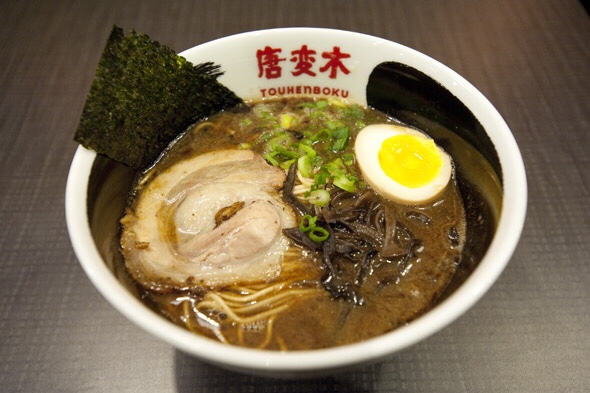
19 Mar A lesson in ramen
Touhenboku Ramen, has ramen that has an distinctive taste that come fromtraditional Japanese slow-cooked chicken broth, called mizutaki. Then the customer adds their choice of thick or thin ramen noodles and a choice of lean pork, rich pork, or chicken chashu. They throw in a little seaweed, a Japanese soft boiled egg, some delicious wood ear mushrooms, and top it off with fresh green onions. Touhenboku Ramen might look like any other ramen shop in Toronto. But look closer and you’ll see a world of difference.
To begin, all chopsticks, ramen spoons and porcelain bowls, which are meant to keep the ramen hot for longer, are imported from Japan – much like the restaurant’s noodle master, Keiichi Machida. I’m told Machida is somewhat of a celebrity in Japan donning the covers of newspapers and magazines. Walk past the open concept kitchen and you’ll see a Japanese artist cranking out dough through a $40,000 noodle-making machine. If this machine looks unfamiliar to you, it’s probably because your favourite ramen shop doesn’t have one. Like most places in the city, they probably order their noodles from a noodle factory in the U.S. The menu is straightforward and offers three styles of ramen: white, red or black, with your choice of lean or fatty pork and sea salt or soy flavouring. But the most unique element is undoubtedly the chicken broth, which until now was unfamiliar to ramen loving Torontonians.
This rich, mizutaki-style chicken broth contains less fat than the usual pork broth. It seems like the broth of most ramen places is either too salty or too bland. Touhenboku, however, falls somewhere in between in that place known as perfection. Perhaps because Okuyama is serious about the art of ramen-making. In fact, he’s so serious he actually attended ramen university in his native country (yes, they have that in Japan). So sit back and enjoy a lesson in traditional ramen as Touhenboku tries to school the competition.



